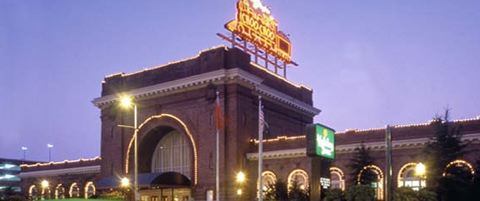 The Virtuous Traveler, Leslie Garrett, took a wrong turn on a road trip and ended up in Chattanooga, Tennessee. Not only did she actually get to climb aboard the Chattanooga Choo Choo (hotel), but she discovered the city’s remarkable green journey from pollution to promise.
The Virtuous Traveler, Leslie Garrett, took a wrong turn on a road trip and ended up in Chattanooga, Tennessee. Not only did she actually get to climb aboard the Chattanooga Choo Choo (hotel), but she discovered the city’s remarkable green journey from pollution to promise.
Geography is not my strong suit.
Which might explain how I wound up in Chattanooga, Tennessee, a place I’d neither wondered about nor sought out.
A place that was completely off course from my intended destination.
A place that I didn’t even really know was a place at all—I thought it was just an annoyingly catchy song (I am Canadian, after all).
Carrying CAA books (the Canadian equivalent of AAA) for four states, plus an incredibly annoying borrowed GPS (“Is that person going to talk at me the whole trip?” was my first question), we were heading north toward Franklin, Tennessee to meet friends. We drove into Chattanooga about the time the kids were getting tired, so we figured we’d just grab a cheap hotel for the night, and then carry on.
But after stumbling onto this small Southern city, I’m completely enamored. Chattanooga might not be in your travel plans either, but it should be, especially if eco-travel is also on your agenda.
For more adventures in the area:
It wasn’t always this way. Chattanooga, in fact, had the dubious distinction of being declared “the dirtiest city in America” in 1969 by the Environmental Protection Association (EPA). There are stories of drivers having to use their headlights during the day to cut through the black, and workers arriving at the office with two shirts so they could change when the first became too filthy. Visitors to nearby Lookout Mountain, which boasts views of seven states, considered themselves fortunate if they could see much of anything.
 But Chattanoogans determined back then that their salvation lay in green living and set about creating a verdant city. Forty years later, their dream is reality and Chattanooga was cited in 1995 by then Vice President Al Gore as offering up a “greenprint” for other cities to emulate.
But Chattanoogans determined back then that their salvation lay in green living and set about creating a verdant city. Forty years later, their dream is reality and Chattanooga was cited in 1995 by then Vice President Al Gore as offering up a “greenprint” for other cities to emulate.
The regeneration began along the Tennessee River, which at the time offered up little more than filthy water. These days, it runs alongside Tennessee Riverpark, 20 miles of trails and parks that stretch right through the city’s core. People can even fish (with a license) and eat what they catch.
The city’s core, which had lost its heart to industry, has been reborn, thanks in large part to the Tennessee Aquarium—six stories of glass, chrome and wonder—which is, quite simply, breathtaking. It was created with conservation as its main goal: to teach it and to model it.
The River Journey building, originally constructed in 1982, focuses on freshwater creatures from the nearby river and around the world. The more recently built Ocean Journey building houses, of course, sea creatures, including sharks, sea turtles and the ever-delightful penguins (if you miss them after your visit, you can watch them 24/7 on the museum’s PenguinCam. What you won’t see at the aquarium or via camcorder is the conservation work by the aquarium on behalf of marine ecosystems around the world—an integral part of the Aquarium’s mandate.
Getting around Chattanooga is a cinch, thanks to bicycle and walking trails and one of the nation’s largest electric bus fleets which is offered free of charge. Because of the city’s great transit, congestion is virtually non-existent.
 As for hotels, the most well-known, of course, is the Chattanooga Choo Choo, a 1908 train terminal with a soaring 85-foot freestanding dome (incidentally the world’s largest). It ceased operating as a train station in 1970, but was saved from the wrecking ball by a group of local businessmen who converted the terminal into a complex with a dining, shops and accommodations out of the old sleeper cars. In 1989, another investment transformed the space into a gorgeous Holiday Inn lobby. Guests can either stay in a regular room or sleep in an authentic refurbished Victorian-era sleeper train.
As for hotels, the most well-known, of course, is the Chattanooga Choo Choo, a 1908 train terminal with a soaring 85-foot freestanding dome (incidentally the world’s largest). It ceased operating as a train station in 1970, but was saved from the wrecking ball by a group of local businessmen who converted the terminal into a complex with a dining, shops and accommodations out of the old sleeper cars. In 1989, another investment transformed the space into a gorgeous Holiday Inn lobby. Guests can either stay in a regular room or sleep in an authentic refurbished Victorian-era sleeper train.
Perhaps it shouldn’t surprise that a city made famous by a railroad—arguably one of the eco-friendliest ways to travel—has effectively greened itself around in a few short decades. Yet it does take some travelers by surprise … especially if, like me, you weren’t really looking for it.
Leslie Garrett is author of The Virtuous Consumer: Your Essential Shopping Guide for a Better, Kinder, Healthier World.Visit her at www.thevirtuoustraveler.com.
Previously By Leslie Garrett:
- Family Travel, Eco-Travel: A Trip to Little St. Simons Island
- Community-Based Tourism: Creating Authentic Travel Experiences
- Off the Brochure(sm) Travel Guide: Toronto, Canada
- Carbon Offsets: Travel With a Clean Conscience?
- America the Beautiful: Postcard from the Edge
- Eco-Beaches
- The Good, The Green and the Downright Crazy Tours
- Green Travel Gadgets
- Green Honeymoons
- Bye Polar: Arctic Travel
Don’t forget to check out our Eco-Travel section for more green travel ideas. Oh, you’re looking for Canada travel, eh? Click here.












